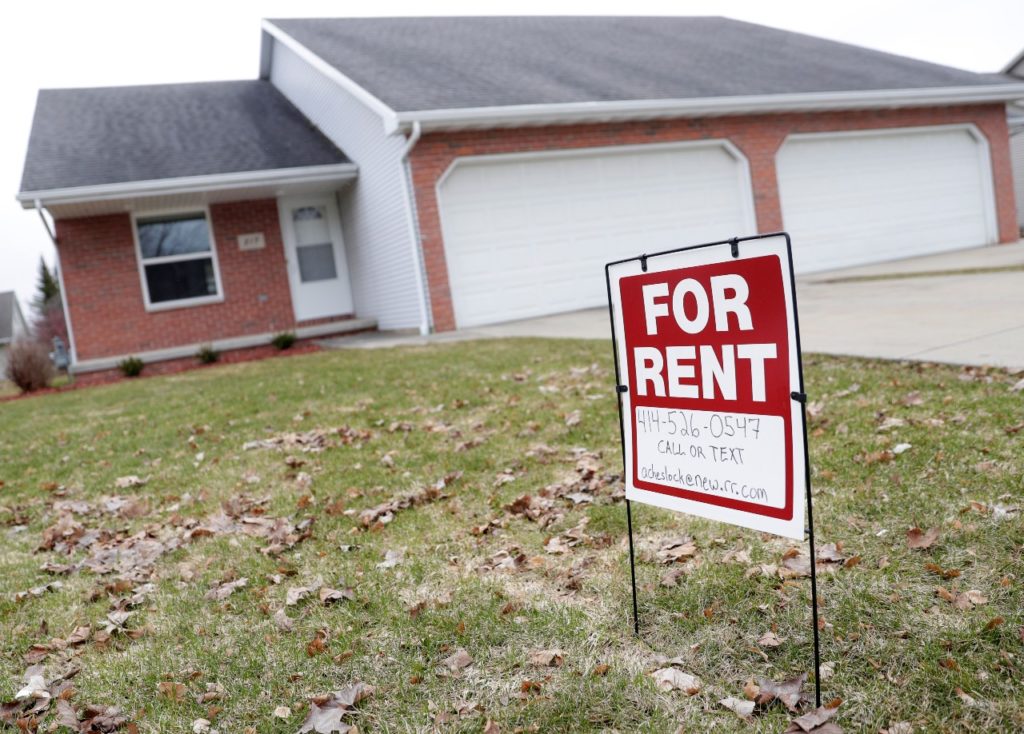
In 20 years of living in Green Bay, Tavalon Love had never faced a challenge with housing such as she does now.
Love has been adrift for months. A single mother of six, she was evicted from her home last year, and has been living in her car, friends’ houses, and hotels ever since. A large portion of her income from her two — formerly three — jobs now goes to paying for hotel stays.
She has been unable to find housing due to her credit score, a conviction from more than a decade ago, and her eviction history. Landlords posting housing ads on Craigslist and Facebook Marketplace often say in the post that they will not take anyone with a low credit score, a criminal background, or an eviction history. That automatic denial locks a lot of people like Love out.
Even though she has adequate income, Love has been told to not even apply when she calls to ask for the opportunity. When she has had the chance to apply, she has been turned down and is losing money through all the application fees.
“I think that they need to just give a person a chance. Like before you click to deny them, at least hear the situation,” Love said. “You never know what happened. I was trying to explain to them I’m working on my credit. How about even if I can pay a couple of months? Give me a chance. Give me a six-month trial. I’ll pay you in advance.”
People like Love are trapped between high rent prices and insurmountable challenges — be it low or no credit, misdemeanors or criminal background, evictions, or no rental history. These barriers ultimately result in families sleeping in cars, motels, outside, or in shelters.

Many families are caught in the affordable housing crisis
The reality is people can be working as hard as they can and still struggle to find affordable housing. In fact, many adults living in a shelter or sleeping in cars have a job or multiple jobs, leaders of area shelters said.
Landlords can be selective about who they rent to because the demand for lower-cost housing exceeds availability.
The Wisconsin Realtors Association estimates new house and apartment construction from 2006 to 2017 in the state’s 20 largest counties fell behind demand by 20,000 units.
In Green Bay, a 2020 housing market study showed the city needs up to 7,400 new rental units and 9,100 owner-occupied units to meet housing demand to 2040. Half of the rental units and 20% of the owner-occupied units would need to serve low-income households.
The city of Appleton’s report on housing and community needs to the U.S. Department of Housing and Urban Development reported the most common housing problem for Appleton households is the amount they pay in housing relative to the total household income.
American Community Survey data organized by the Joint Center for Housing Studies at Harvard University indicates nearly one in three renting households in the Appleton metro area are cost burdened — meaning more than 30% of that household’s income go to housing costs. Nearly one in 5 of all households — renting and owning — are cost burdened.
“Someone can be working. They can find day care. But when they look for housing, they find none,” said Jessica Diederich, president of Freedom House Ministries, an emergency shelter for families in Green Bay.
Besides the shortage of affordable housing, there are other complex root causes to homelessness including generational poverty and addressing mental health challenges, often stemming from childhood trauma. Addressing that requires counseling, mental health services, and case management, said Alexia Wood, director of St. John’s Homeless Shelter.
Wood said the Micah Center, under St. John’s, is a resource center for community members experiencing homelessness. While there are career resources and employee training workshops at the center, it isn’t just a matter of someone getting a job to counter homelessness – a misconception held by many people in the wider community.
“I feel like there’s this perception that individuals experiencing homelessness should simply get a job,” Wood said. “Like I think that’s kind of the bias we’re facing. Every employer in town I’m pretty sure has a help wanted sign, with hiring bonuses and all of that. And so, I would ask for compassion and grace in recognizing— there’s so much needed in the workforce, local workforce— that it’s not a job problem. It’s larger than that.”
Appleton resident Laquita Stevenson faced a series of challenges in her search for secure housing for her family. She and her children moved from Kenosha in 2016 because she wanted her kids to grow up in a safer environment. She was also leaving an abusive relationship.
The family lived in a domestic violence shelter until staff at the shelter helped them move into their first apartment. At the end of the lease for that apartment, Stevenson and her family did not have anywhere to go. A case manager at Pillars in Appleton, an organization dedicated to providing shelter and support for people experiencing homelessness, helped find the family find a three-bedroom home.
Stevenson, 39, said making sure her five children have a safe, stable home “is my number one goal for the rest of my life here on earth because when I was younger, my mom put me out. I didn’t have anywhere to go, nobody to turn to and I would never put my kids in that situation.”
Many families are working through generational poverty, where generations of that clients’ family have lived in poverty, Wood at St. John’s said. Those clients grew up in poverty, and perhaps even those clients’ parents grew up in poverty. The cycle is difficult to break.
The Ecumenical Partnership for Housing in downtown Green Bay, a partnership between 19 area churches working to address homelessness, supports families with children with its 35 transitional and supportive housing units.

DeEtte Radant, an EPH caseworker, said the agency is serving families in generational poverty.
Over time, families’ lack of access to suitable, stable housing and reliance on community support becomes “embedded in the culture,” Radant said.
“All of us facing the issue of homelessness understand the generational experience of poverty,” Radant said. “Their grandparents were homeless. For us, it’s working with families who don’t know any other lifestyle.”
There are different measures used to understand the scope of homeless in our communities.
For example, a point-in-time count is collected twice a year that takes into account people who are both in shelters and unsheltered tp account for those who have and have not accessed homeless services. January 2020 data indicates 243 households were experiencing homelessness in Brown County at that time. In Outagamie County, 222 households were homeless.
There’s also in-flow data, which indicates who’s making it into shelter on an annual basis. In Brown County, shelters reported that 54% of their clients did not have children, while 46% of clients were in households with children. In the Fox Cities, 30% of the clients in shelter were households that included children.
Housing first: Providing shelter before addressing root causes of homelessness
Housing advocates say one solution to community homelessness is the housing-first model, centered around the principle that every person’s first and foremost need is to have a roof over their head. Once the immediate need of housing is addressed, people can more effectively work on the underlying issues that caused housing loss or homelessness.
Jim Mauthe, executive director of Pillars in Appleton said home is foundational to growth in other aspects of life.
“When you don’t have stable housing under your feet, how can we expect kids to excel in their schooling, how can you be a great employee, how can you take care of your health if you’re not in a safe or stable place to live?” Mauthe said. “So it ends up being kind of self-perpetuating that the lack of good housing leads to other problems that compound the lack of good housing.”
This year, when Stevenson was unable to work after the death of a close friend, Pillars helped her cover her rent so she and her kids could stay in the home.
“I was really worried about us being evicted because they’re young teenagers now and they’re getting out and exploring Appleton and, you know I love that about them,” Stevenson said of her kids, 19, 15, 13, and 11-year-old twins. “They get to hang out with friends and we’re right here by a park and it’s like real convenient for us to be here.”
Housing advocate Steph Birmingham works with the Brown County Homeless & Housing Coalition and works for Options for Independent Living, a nonprofit dedicated to empowering people with disabilities to live productive, independent lives. Birmingham coordinates a grant-funded certified peer specialist program for people with substance-use issues in NEWCAP’s Permanent Supportive Housing Program.
She believes, ideally, people should be able to live in a quality place where they can actually flourish. She thinks we should think more long-term when we house currently and formerly homeless people.
“There are individuals who have higher needs, and that’s just the fact of the matter,” Birmingham said. “As a society, we have to say yes and make a commitment. Because I don’t think committing only halfway does justice to anybody.”
Designing and building housing to foster social connection could prevent homelessness
Wood, the director of St. John’s Homeless Shelter, sees the systemic causes of homelessness on the daily. In her opinion, the way to address homelessness in the long run isn’t to expand the shelter’s capacity — though St. John’s has expanded — but to prevent homelessness from happening in the first place.
Wood envisions affordable housing units not just for homeless or formerly homeless individuals, but also for people across all income levels and backgrounds. St. John’s calls this vision “socially inclusive housing.”
Imagine smaller-size units with up to four bedrooms for larger families. A resident would have a kitchenette if they wanted to cook dinner for themselves, but there would also be community spaces like a community dining room and a community for residents to gather.
“And then through the organic relationships through those intentional spaces, that’s where a lot of the decreased cost of living comes in,” Wood said.
Building spaces for social connection can lead to decreased living costs and housing stability.
Take this for example, Wood said: A single mother might grab food or a prescription for an elderly neighbor. The elderly neighbor, in turn, might pick up the mother’s kids at the bus stop when the mother works late.
“And that natural give-and-take of relationships: it’s shown to have decreased cost of living with improved life satisfaction because you’re actually in community with your neighbors,” Wood said.
In essence, the safety housing brings isn’t just a physical roof over your head. It is also the opportunity to be a neighbor and to have the care of a neighbor in return. Longterm housing stability means having a social network, like a neighborhood, to rely on.
It might seem unexpected to bring together different populations – young professionals, elderly, and cost-burdened families – but there’s a social benefit to unifying everyone.
“The needs are similar. The goals are the same. The loneliness — if you study loneliness of some of those subpopulations — it’s exactly the same,” Wood said.
Mixed income development is an ideal for developers who seek to provide affordable units to the community.
Carla Cross, president and CEO of Milwaukee-based Cross Management, is among the developers working to develop affordable housing in Sister Bay in Door County. Cross is working with Milwaukee-based developer Marissa Downs on the project.
Called The Shoals,” the Sister Bay development in Door County will have 45 affordable housing units, partly funded through tax credits issued by the Wisconsin Housing and Economic Development Authority.
Cross has advocated for mixed-income housing. Mixed income housing allows people and their children from different backgrounds and professions to get to know each other.
Although many communities’ zoning rules create barriers to developing mixes of single-family homes and more dense multi-family developments, particularly those aimed at lower income residents, Cross sees such developments as places where residents can build the type of naturally formed connections that are common in small towns.
“In small towns, the banker’s kids and, let’s say the grocery store owner’s kids, and the guy who works as a laborer for the city’s (kids)— they all go to school together and interact,” Cross said as example. “You have people within the whole income spectrum, even people who are in poverty, and they all are interacting because it’s a small town and there’s probably only one school … you get a chance to know people.”
“It also could be inspiring to see or come in contact with people who are in different income levels than you are, and it can inspire you to do greater things,” Cross said.
Wood and other housing advocates hope to take a preventative approach so that community members won’t have to face the trauma of homelessness.
“The struggle when you’re looking at trying to find a bed for everybody who’s homeless is you are waiting for them to fall off the cliff, then you complete a coordinated entry assessment, then they go on the prioritization list, and now we’ve got this backlog list that we’re trying to get into housing,” Wood said. “And we’re sitting there going, ‘But why in the world do we let them approach the cliff in the first place?'”
Jeff Bollier of the Green Bay Press-Gazette and Natalie Brophy of the Appleton Post-Crescent contributed to this article.




























